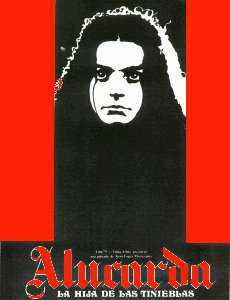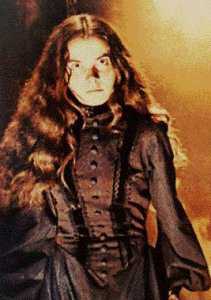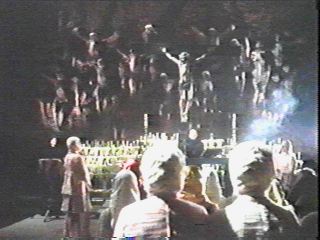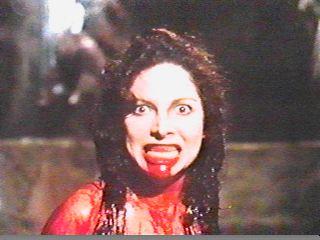
(Films 75-Yuma Films, 1975) Prod: Eduardo Moreno, Max Guefen; Dir: Juan
López Moctezuma; Scr: Juan López Moctezuma, Yolanda
López Moctezuma, Alexis T. Arroyo; Photo: Xavier Cruz; Music: Tony
Guefen; Prod Mgr: Antonio Rodríguez; Asst Dir: Rafael
Villaseñor; Film Ed: Max Sánchez; Art Dir: Kleomenes
Stamatiades; Special FX: Abel Contreras; Makeup: A. Ramírez del
Río; Sound Rec: Francisco Guerrero; Re-rec: Ricardo Saldivar; Sound
Ed: Jorge Peña; Union: STIC 
CAST: Claudio Brook (Dr. Oszek; hunchbacked gypsy), David Silva (Father Lázaro), Tina Romero (Alucarda), Susana Kamini (Justine), Adriana Roel (Sister Germana), Martín Lasalle (Brother Felipe?), Tina French (Sister Angélica), Lily Garza (Daniela Oszek), Betty Catania (nun), Manuel Dondé (wagon driver), Birgitta Azkenazy [Segerskog] (mother superior), Rosa Furman, Tito Novaro (monk), Victorio Blanco (monk), Agustín Isunza (monk), Edith González (village girl), Kleomenes Stamatiades, Juan López Moctezuma (monk)
NOTES: This film was apparently shot in English and was later dubbed
into Spanish for its Mexican release. The English-language version (which
is the one I have seen) features Claudio Brook and (apparently) Tina
Romero (and possibly David Silva) doing their own voice-work. As noted in
my review of La mansión de la locura, I believe López
Moctezuma shot his '70s films primarily in English, using mostly
English-speaking performers (although some minor characters' dialogue may
have been post-dubbed).
The plot synopsis of the film printed in Emilio García Riera's
Historia documental del cine mexicano varies considerably from the
English-language version, although it is possible that his source for the
synopsis (he doesn't seem to have screened the film himself) was in error.
Some scenes he describes are not in the English-language version, and a
reference is made to a third role played by Claudio Brook, but only
two are seen here. The English-language version released on Academy video
runs 76 minutes, nine minutes shorter than the running time cited by
García Riera. 
After a prelude in which a young woman (Tina Romero) gives birth to a baby in barn and hands it over to a wild-looking gypsy for safe-keeping, the film begins with the arrival of Justine--whose parents recently died--at a convent/orphanage run by an order of nuns. The year is 1868. Justine is befriended by Sister Angélica, who shows her the room she will occupy. Justine's roommate is the black-clad Alucarda, who seems a bit (well, quite a bit) odd. However, the two teenage girls become friends.
One day the duo wanders away from an outing in the woods. They meet the hunchbacked gypsy, who invites them to his encampment. There, a gypsy woman starts to read Justine's palm but turns away; Alucarda is upset by the hunchback's cryptic statements, and dashes off. Justine and Alucarda discover a strange, ruined house in the forest; inside, they find a crypt containing a moldering corpse. When they open the coffin, a strange roaring sound is heard, and they run away.
Back at the convent, Justine faints during a fiery sermon preached by
Father Lázaro. Later, Alucarda becomes possessed by a demon; the
gypsy hunchback appears in their room; using a dagger, he pricks their
breasts and forces them to drink each other's blood. The two girls
participate in an orgy in the woods, but Sister Angélica's prayers
seem to call up a strange power which strikes down the gypsy woman.
During a catechism class, Justine and Alucarda mock the nun in charge and
begin to praise Satan. Justine collapses into shock; Alucarda attacks
Father Lázaro in the confessional. He comes to the logical
conclusion: "That's it--a heliophobic demon! That's a sixth-category
devil who hates light! We must prepare--an EXORCISM!" (You have to admit
it, the man knows his demonology) 
Justine is stripped and tied to a cross. She is pierced with needles while Alucarda--also tied up--looks on helplessly. When she screams in protest, Alucarda is knocked out. The town doctor, Dr. Oszek, arrives and criticizes the monks and nuns for their hysterical behavior, but it is too late: Justine is dead. Oszek takes the unconscious Alucarda back to his house. Alucarda is befriended by Daniela, Oszek's blind teenage daughter.
Dr. Oszek is called back to the convent: Justine's body is missing,
and the horribly-burned corpse of a nun is discovered. Father
Lázaro chops the head off of the body with a sword, and the
"corpse" screams and twitches. Oszek learns that Alucarda has taken
Daniela away. The searchers go to the mysterious house in the woods.
Sister Angélica finds the nude Justine lying in a coffin full of
blood. Justine revives and attacks the nun, but then becomes calm.
However, Oszek arrives and tosses holy water on her, which burns the
undead Justine like acid. Before she dies, Justine bites
Angélica's throat, killing her.

Oszek and the others return to the convent, where Alucarda is terrorizing the nuns, the monks, and the orphaned girls. The building shakes, people burst into flames. Alucarda is upset when Daniela, bewildered by the commotion, falls down a flight of stairs. The monks bring in Angélica's dead body, holding it aloft in a Christ-like pose. Alucarda is overcome by this image, and dies, her body disappearing.
Alucarda is a bizarre and confusing film, with definite echoes of Jodorowsky, López Moctezuma's friend and associate. For the exploitation crowd, it has a fair amount of gore and considerable full nudity, although even the most hardened bad-film aficionado would probably flinch at some of the stilted dialogue in the earlier sections. The plot cannot be "explained" simply (in fact, the synopsis given by García Riera alludes to vampiric aspects which simply do not exist in the English-language version), although basically it has to do with demonic possession. But whether this is caused by the coffin that Justine and Alucarda open, thus "releasing" a demon or spirit, or whether it is caused by the hunchback gypsy (= the devil), or both, is not made clear. López Moctezuma indicated that he initially planned a two-film series, so perhaps the sequel (which was never made) would have explained something. The film isn't exactly anti-clerical: while Dr. Oszek berates Father Lázaro and the nuns for torturing Justine to death, it later turns out their diagnosis of demonic possession was (apparently) correct. Furthermore, Sister Angélica is a positive figure throughout the film, and the other church members are depicted as somewhat overzealous, but not evil.
Alucarda is, at least visually, a rather stylish and interesting picture. The nuns wear non-traditional outfits, dirty-white looking gowns and head-gear that makes them look sort of like mummies. The old house in the forest--and the convent, to a lesser extent--have rather "organic" interiors, as if designed by Alien artist H.R. Giger. The photography and other technical aspects of the film are satisfactory, and althought the film was (according to López Moctezuma) made very cheaply, it does not look that way.
Top-billed Claudio Brook chews the scenery as the hunchback, speaking
garbled German-French, and wearing outrageous makeup (curly wig, stringy
goatee, snaggle-teeth), but is nondescript as the skeptical Dr. Oszek.
Tina Romero is convincingly weird as Alucarda, although she rather too
quickly forgets about the dead Justine and adopts the innocent Daniela as
her new friend (with definite lesbian overtones). Susana Kamini, who
appeared in four of López Moctezuma's feature films (and little
else, unfortunately, since I think she's great), has her largest
role here, and is perfectly adequate, as well as being quite attractive.
The film's best scene is Kamini's emergence from the blood-filled coffin.
Kamini's feral attack on her former friend--and then the sudden cessation
of violence, as recognition dawns in her eyes--is extremely well-done.
Kamini's naked, blood-covered body is not used in an exploitative manner
at all in this scene, unlike the earlier sequences which combine sex and
gore for titillation.
The vidcaps above come from the excellent Cult Cuts page
here.